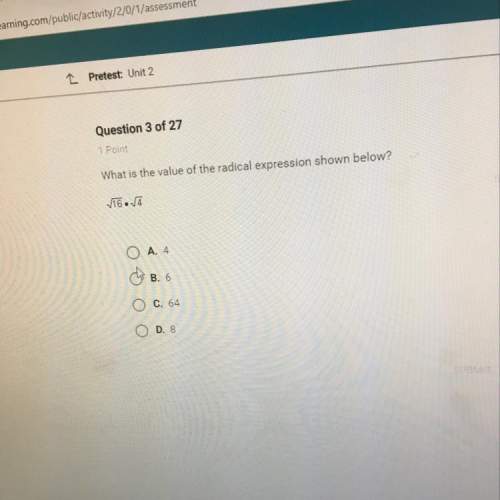
Mathematics, 11.04.2020 03:26 Savageboyn
Out of a total of N students at a school, the number of students who have seen a new television program increases at a rate proportional to the product of the number of students who have seen the program and the number of students who have not seen the program. If S denotes the number of students who have seen the program at time t, which of the following differential equations could be used to model this situation, where is a positive constant?
ks - kt
( N1) -AS
(N-S) D - KS (- N)
None of the above

Answers: 2


Another question on Mathematics

Mathematics, 21.06.2019 23:40
Select the correct answer what is the 10th term of the geometric sequence 3,6, 12, 24,48 a. 512 b. 3,072 c. 768 d. 1,536
Answers: 2

Mathematics, 21.06.2019 23:40
Which is the scale factor proportion for the enlargement shown?
Answers: 1

Mathematics, 22.06.2019 00:30
Tim has obtained a 3/27 balloon mortgage. after the initial period, he decided to refinance the balloon payment with a new 30-year mortgage. how many years will he be paying for his mortgage in total?
Answers: 2

Mathematics, 22.06.2019 03:00
In this problem, we explore the effect on the standard deviation of multiplying each data value in a data set by the same constant. consider the data set 14, 6, 8, 15, 15. (a) use the defining formula, the computation formula, or a calculator to compute s. (round your answer to one decimal place.) s = 4.28 (b) multiply each data value by 3 to obtain the new data set 42, 18, 24, 45, 45. compute s. (round your answer to one decimal place.) s = 12.83 (c) compare the results of parts (a) and (b). in general, how does the standard deviation change if each data value is multiplied by a constant c? multiplying each data value by the same constant c results in the standard deviation remaining the same. multiplying each data value by the same constant c results in the standard deviation being |c| times as large. multiplying each data value by the same constant c results in the standard deviation increasing by c units. multiplying each data value by the same constant c results in the standard deviation being |c| times smaller. (d) you recorded the weekly distances you bicycled in miles and computed the standard deviation to be s = 3.8 miles. your friend wants to know the standard deviation in kilometers. do you need to redo all the calculations? yes no given 1 mile ≠1.6 kilometers, what is the standard deviation in kilometers? (enter your answer to two decimal places.)
Answers: 1
You know the right answer?
Out of a total of N students at a school, the number of students who have seen a new television prog...
Questions

Health, 15.01.2020 07:31



Biology, 15.01.2020 07:31


English, 15.01.2020 07:31

Mathematics, 15.01.2020 07:31

Mathematics, 15.01.2020 07:31


History, 15.01.2020 07:31


Mathematics, 15.01.2020 07:31


Geography, 15.01.2020 07:31





Mathematics, 15.01.2020 07:31




